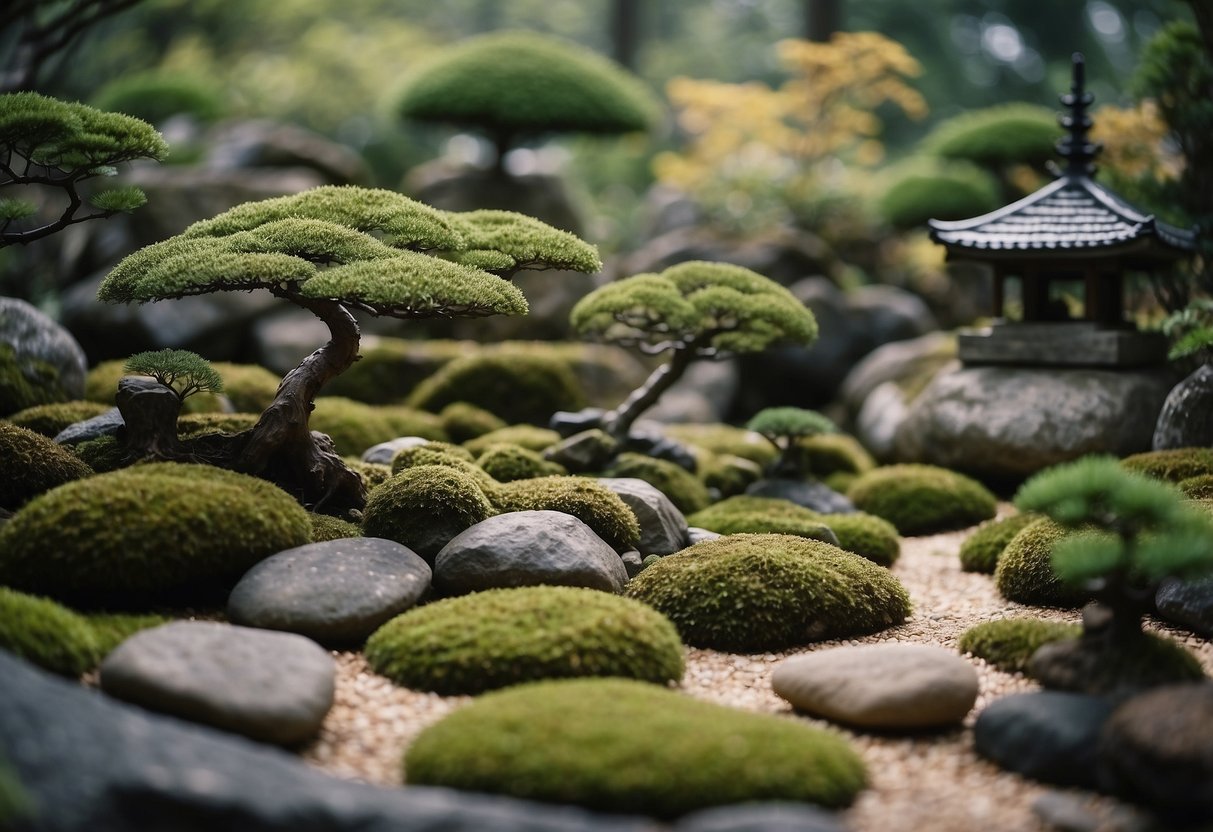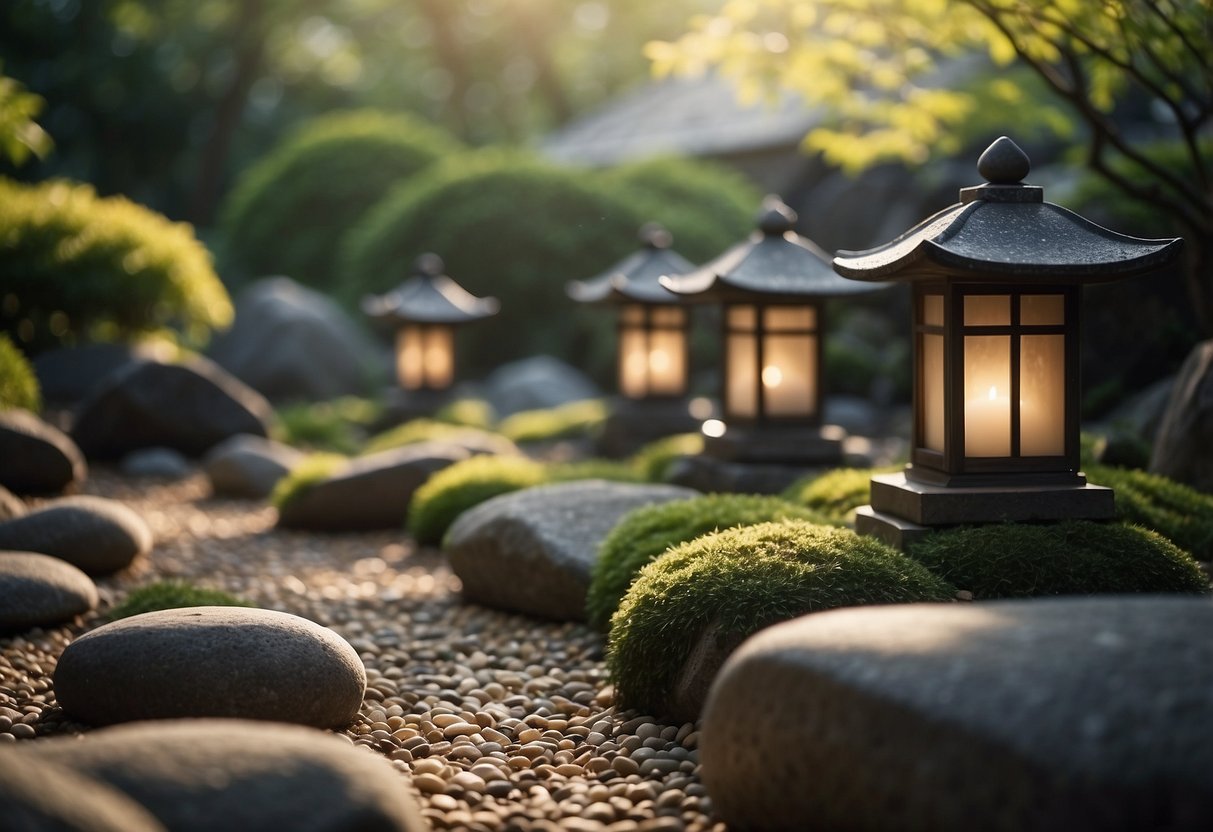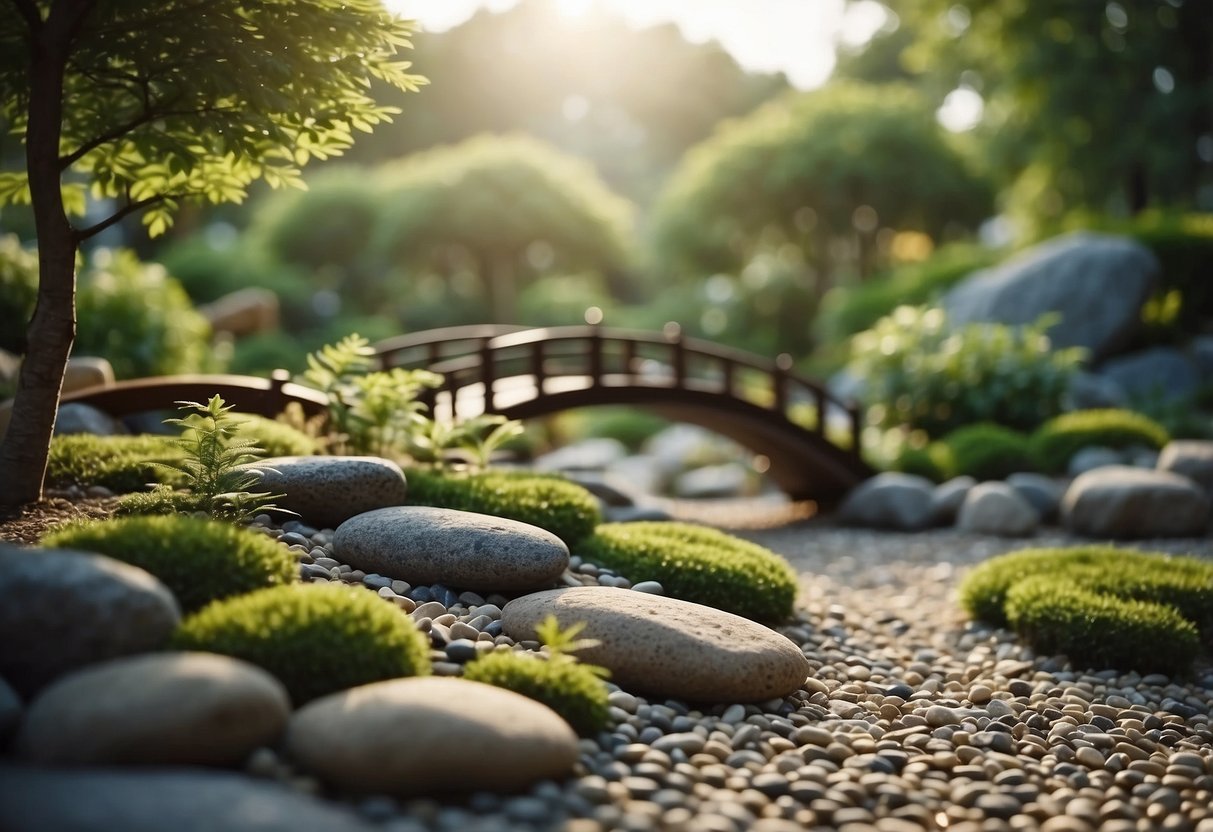Japanese Rock Garden Ideas: Transform Your Yard into a Tranquil Oasis
Creating a Japanese rock garden can transform your outdoor space into a peaceful retreat. These gardens, known for their simplicity and elegance, use rocks, gravel, and carefully placed plants to mimic the essence of nature. But what makes Japanese rock gardens truly special is their ability to foster a sense of tranquility and mindfulness.

As you consider adding a Japanese rock garden to your landscape, think about how it can provide a serene escape from the hustle and bustle of daily life. With the right design elements and thoughtful placement, your garden can become a calming haven right in your backyard.
1) Sand Raking Patterns

Creating sand raking patterns in a Japanese rock garden adds to its beauty and tranquility. You can try long, wavy lines to imitate a stream. This pattern, called Kyokusen-mon, is achieved by dragging your rake with a gentle wiggle.
You might also want to try simple, straight lines that extend across the entire garden. These lines are easier to make and add a clean, minimalist look.
Each pattern can transform your garden into a peaceful retreat, making it a perfect place for meditation and reflection.
2) Koi Pond Integration

Adding a koi pond to your Japanese rock garden can make it feel even more peaceful. Koi fish are not just beautiful to look at, but their gentle movements add a calming vibe.
Use natural materials like bamboo, stone, and gravel. A stone bridge or stepping stones can be a great way to enjoy your koi pond up close.
Think about how the pond fits into the garden’s overall design. Koi ponds are often paired with features like stone lanterns or small waterfalls. This creates a harmonious and relaxing environment for you to enjoy.
3) Traditional Stone Lanterns

Traditional stone lanterns, or toro, are key elements in Japanese rock gardens. They often add a touch of serenity and history.
These lanterns come in various designs. For example, Yukimi-Gata, also known as snow-viewing lanterns, have legs and a broader top.
Adding a stone lantern to your garden can create a tranquil ambiance. Lanterns like these are often placed near water features or paths to enhance the peaceful atmosphere.
4) Bamboo Water Features

Bamboo water features can add a unique touch to your Japanese rock garden. These features often include a bamboo pipe, known as a kakei, which guides water into a stone basin.
The sound of water gently flowing through bamboo creates a soothing atmosphere. Bamboo is also durable and can easily withstand outdoor conditions.
You can find more ideas for bamboo water features at Japanese Garden Bamboo Water Fountain Ideas.
5) Moss Ground Cover

Moss is a fantastic choice for your Japanese rock garden. It creates a soft, green carpet that looks serene and peaceful.
Japanese gardens often use moss to cover the ground between rocks and other plants. It thrives in shady spots and doesn’t need much maintenance.
Using moss in your garden can add a touch of elegance and tranquility, making your space look like a peaceful retreat. For more details, check out this ideal ground cover guide.
6) Stepping Stone Paths

Stepping stone paths are a key feature in many Japanese rock gardens. They encourage a mindful walk, helping you focus on each step.
Arranging stones in an uneven pattern slows you down, letting you enjoy the garden’s surroundings. This method was popular during the Momoyama period.
Walking on these paths can create a serene atmosphere. The smooth stone texture under your feet adds to the experience. For more ideas, check out this guide on Japanese garden pathways.
7) Zen Garden Bridges

Zen garden bridges are a wonderful addition to any Japanese rock garden. These simple structures can be both functional and beautiful.
A popular choice is the minimalist arched bridge. It spans over small water features or rock pathways, adding visual interest.
Wooden bridges create a sense of connection with nature. They blend seamlessly into the serene garden setting.
Incorporating a bridge can enhance the tranquility and harmony of your Zen garden. It also invites you to slow down and enjoy the scenery.
8) Pruned Pine Trees

Pruned pine trees add a sophisticated touch to your Japanese rock garden. The art of Niwaki, or pruning trees in the Japanese style, emphasizes the natural beauty of the tree.
To start, use sharp and clean tools like shears, loppers, and a saw. This helps make precise cuts that don’t harm the tree. Remove unnecessary candles and shorten the remaining ones to about two-thirds of their original height.
Understanding the growth patterns and careful pruning will keep the tree healthy and visually appealing. This thoughtful pruning showcases the tree’s gnarled trunks and outstretched branches, enhancing the garden’s aesthetics.
9) Minimalist Seating Areas

Creating a minimalist seating area in your Japanese rock garden can enhance its serene ambiance. A simple wooden bench or a stone seating arrangement blends well with natural elements.
You can place the seating near a tranquil koi pond or along a curved stone pathway.
Choose materials like smooth stone or untreated wood to keep the natural look. Keep the design simple to maintain the minimalist feel.
10) Stone Pagodas

Stone pagodas can add beauty and elegance to your Japanese rock garden. These structures come in various shapes and sizes, making it easy to find one that fits your space.
The pagodas can serve as focal points, drawing attention to specific areas. They can be combined with plants and rocks to enhance their visual appeal.
At night, you can place a small candle inside a stone pagoda. This will create a warm and enchanting glow, adding a magical touch to your garden. Incorporating a stone pagoda can help you achieve a harmonious and peaceful atmosphere.
Fundamentals Of Japanese Rock Gardens

Japanese rock gardens, also known as Zen gardens, are deeply rooted in cultural history and follow specific design principles. These gardens use rocks, sand, and minimal vegetation to create serene, meditative spaces.
History And Philosophy
Japanese rock gardens date back to ancient times, with origins in Buddhist, Shinto, and Taoist traditions. The primary purpose of these gardens is to inspire meditation and contemplation. Buddhist monks first used them to aid in their meditation practices.
The philosophy focuses on simplicity and natural harmony. Rocks and sand are used to represent mountains, water, and other natural elements. This helps create a miniature landscape that invites peaceful reflection. Japanese rock gardens often emphasize the beauty of asymmetry and the passage of time.
Key Elements And Principles
Key elements include rocks, sand, and sparse vegetation. Rocks are carefully placed to symbolize mountains or islands. Sand is raked into patterns representing water or waves.
Moss is a common feature, adding a touch of green and symbolizing landforms. Pathways are usually made of gravel or stepping stones. Plants like bonsai trees and small shrubs may also be used sparingly.
Principles such as wabi-sabi (beauty in imperfection) and shakkei (borrowed scenery) guide the design. The goal is to create a natural, balanced look that feels timeless and tranquil. Minimalism is key, focusing on what is essential and leaving out anything unnecessary.
For more details on design ideas, you can explore Modern Japanese Rock Garden Ideas or learn about the Art of Dry Landscaping.
Designing Your Japanese Rock Garden

Creating a Japanese rock garden involves choosing the right rocks, incorporating plants and moss, and achieving balance and harmony. Each element plays a crucial role in crafting a tranquil and aesthetically pleasing garden.
Choosing The Right Rocks
Selecting the right rocks is essential for an authentic Japanese rock garden. Focus on natural shapes and textures. Avoid using artificially shaped stones. Look for rocks of different sizes to add variety.
Opt for rocks that have earthy tones like grey, brown, or black. Place the rocks thoughtfully, as they represent mountains or islands. Use larger rocks as focal points and smaller ones to create pathways or borders.
Position rocks in odd numbers, as this creates a more natural and balanced look. Ensure they are partially buried to look as though they have been there for a long time.
Incorporating Plants And Moss
Plants and moss add life and color to your garden. Choose low-maintenance plants such as Japanese maples, bamboo, and azaleas. These plants thrive well and add layers of texture and color throughout the seasons.
Include moss in shaded areas to give your garden a lush, soft appearance. Moss is significant in Japanese gardens as it symbolizes age and tradition. You can also use ground cover plants like ferns to complement the rocks and add greenery.
Keep the plant arrangement simple and uncluttered. Prune the plants regularly to maintain their shape and health. This will ensure your garden remains serene and inviting.
Creating Balance And Harmony
Balance and harmony are key principles in Japanese garden design. These elements create a peaceful and tranquil space. Incorporate elements like water, sand, and stone to represent natural elements such as rivers, oceans, and mountains.
Use raked sand or gravel to symbolize water. Patterns created in the sand add a calming effect. Incorporate a stone lantern or a small water feature to enhance the ambiance.
Consider the placement carefully, ensuring each element complements the others. Maintain open spaces to provide a sense of calm and simplicity. Balance is achieved by combining various elements harmoniously, ensuring your garden feels cohesive and serene.







